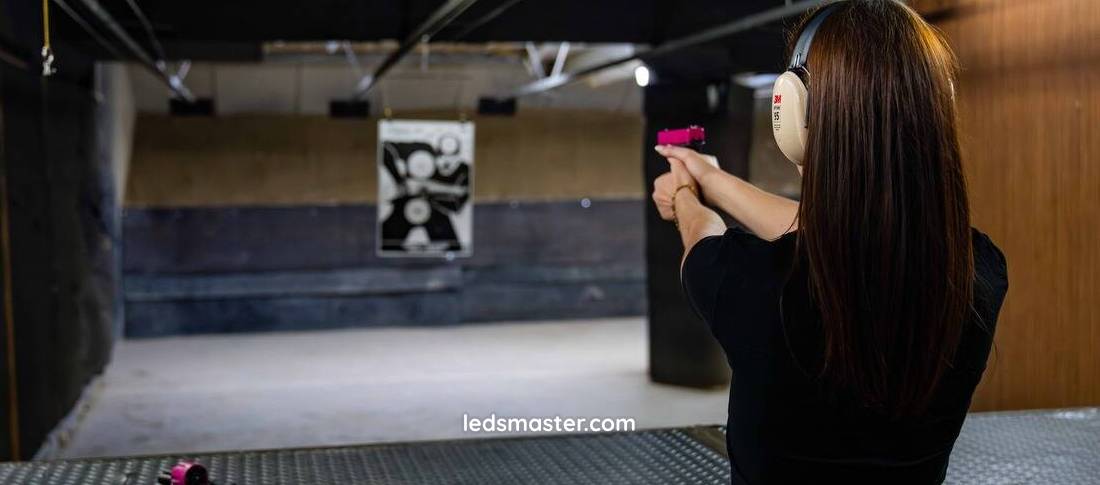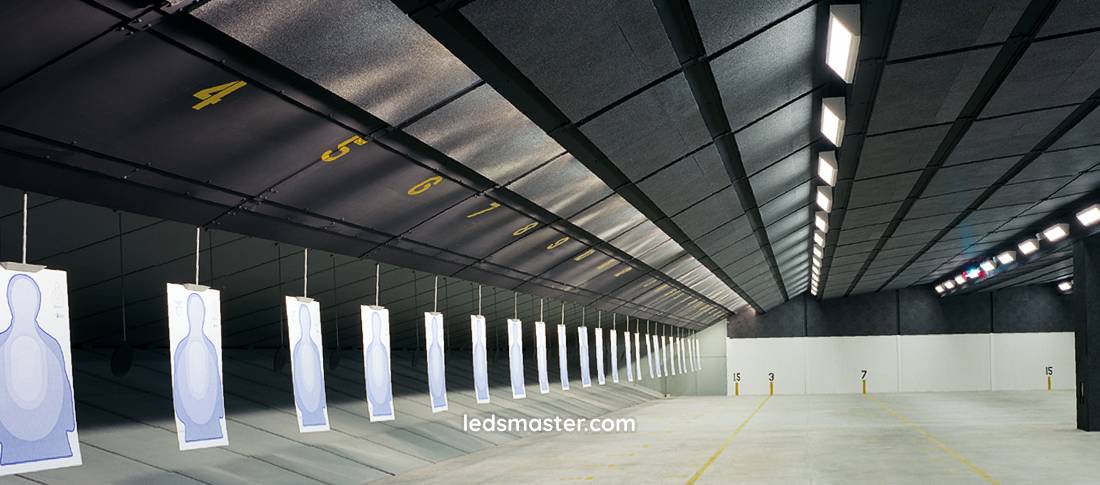Elevate your shooting range experience with our state-of-the-art Shooting Range Lighting. Engineered for optimal visibility and precision, our advanced LED systems minimize shadows and eliminate glare, ensuring clear sightlines for enhanced accuracy during practice or competitions.
Our innovative LED systems are crafted to optimize visibility and precision, crucial for both recreational shooters and professional marksmen. Featuring glare-free technology that minimizes distractions and shadows, our lights ensure consistent brightness across the entire range, enhancing target clarity and shot placement. With adjustable brightness settings and robust, weather-resistant designs, our lighting solutions are built to withstand the rigors of any shooting environment, from indoor ranges to outdoor facilities.
Get your complimentary lighting design today
The objective of any lighting system in this context is to provide sufficient illumination while minimizing glare and shadows, thereby enhancing target visibility and overall shooting accuracy. When shooters step onto the range, they need to have confidence in their ability to see their targets clearly and make precise shots. Lighting that does not meet these criteria can lead to poor performance and even safety issues.

Lighting systems in shooting ranges must be designed to create optimal conditions for shooters. This involves considering the types of activities conducted within the range, the layout of the shooting area, and the specific needs of shooters. For example, different shooting disciplines may require varying levels of brightness and illumination angles to achieve the best results. Consequently, lighting solutions must be tailored to the unique demands of each shooting environment.
Table of Contents
ToggleAmong the various lighting options available, LED lights have emerged as the preferred choice for shooting ranges due to their numerous benefits. One of the standout features of LED technology is its energy efficiency. LEDs consume significantly less power compared to traditional lighting sources, resulting in lower operational costs. This energy efficiency is not only beneficial for range operators but also contributes to environmental sustainability by reducing the overall carbon footprint of the facility.
The longevity of LED lights is another advantage. With lifespans often exceeding 25,000 hours, LEDs require less frequent replacements, minimizing maintenance efforts and associated costs. This reliability is particularly advantageous in busy shooting ranges where downtime for maintenance can disrupt operations and affect the shooting experience for patrons. Furthermore, the consistent brightness offered by LED lights ensures that shooters can see their targets clearly, enhancing their ability to focus on their aims.
Another benefit of LED lighting is its ability to produce bright, uniform illumination. Unlike traditional incandescent or fluorescent lights, which can create hotspots and uneven lighting, LEDs provide even light distribution across the shooting range. This uniformity is critical for ensuring that shooters can maintain focus and avoid distractions that can arise from uneven lighting. When lighting is consistent, shooters can concentrate on their technique and performance, leading to improved accuracy and confidence.
When assessing shooting range lighting, brightness and uniformity are factors that must be considered. Effective lighting should provide a consistent level of brightness across the entire shooting range, eliminating harsh shadows and hotspots that can impede visibility. Shooters need to see their targets clearly from various positions, and inadequate lighting can lead to misjudgments and errors.
LED lights excel in providing uniform light distribution. This characteristic not only benefits shooters but also enhances the overall shooting experience. When lighting is uniform, shooters can focus more on their techniques rather than adjusting to varying light conditions. This leads to improved accuracy and a more enjoyable time on the range.
In addition to uniformity, to consider the overall brightness levels required for different shooting conditions. Different shooting scenarios may call for varying brightness levels. For example, daytime shooting may benefit from higher brightness levels to counteract ambient light, while evening shooting might require dimmer lights to create a more comfortable environment. The ability to adjust brightness levels easily is a valuable feature in modern lighting solutions, allowing shooters to customize their environment to match their specific needs.
Flexibility in lighting settings accommodate the diverse conditions that shooters may encounter. Modern LED lighting solutions often come equipped with adjustable brightness levels and color temperature options, enabling shooters to tailor the lighting to their preferences. This adaptability is particularly useful for shooting ranges that host a variety of shooting activities, from competitive shooting to recreational practice.
For instance, certain training scenarios may benefit from simulating natural daylight conditions, which can enhance shooters’ ability to adapt to different lighting environments. By providing a more realistic training experience, shooters can better prepare for outdoor conditions where lighting may vary significantly. Conversely, in a controlled indoor environment, shooters may prefer dimmer lights for evening sessions to reduce glare and improve comfort.
Furthermore, the capability to customize lighting conditions can help shooters develop a deeper understanding of how different lighting affects their shooting performance. By experimenting with various brightness levels and color temperatures, shooters can learn to adjust their techniques and improve their overall skills.
Glare presents a challenge in shooting environments, hindering visibility and concentration. Excessive glare can distract shooters, making it difficult for them to maintain focus on their targets. Anti-glare technology integrated into shooting range lighting systems mitigates these issues by minimizing reflections and glare. This ensures clear sightlines without compromising brightness, creating a more conducive environment for shooting.
Effective diffusion of light is key to reducing glare. Advanced anti-glare technologies work by distributing light evenly and minimizing specular reflections that can create distracting spots on the shooting range. As a result, shooters can maintain their focus on the target without the hindrance of excessive glare, leading to improved shooting performance.
Reducing glare also contributes to visual comfort for shooters. Eye strain can be a significant concern during extended shooting sessions, and effective lighting solutions that minimize glare can help alleviate this issue. By creating a comfortable and visually pleasant environment, shooters are better equipped to concentrate on their performance and achieve their shooting goals.
High-quality shooting range lighting is constructed from robust materials that can withstand environmental factors such as humidity, dust, and temperature fluctuations. These elements can significantly impact the performance of lighting systems, making it essential to choose fixtures designed for durability.
LED lights are inherently durable and resistant to shock and vibration, making them well-suited for installations in outdoor shooting ranges. The robust construction of LED fixtures ensures that they can withstand the rigors of outdoor environments, providing reliable lighting for shooters regardless of the conditions. Furthermore, weather-resistant enclosures and appropriate IP ratings add an additional layer of protection, ensuring that lighting systems can maintain peak performance even under challenging conditions.
Choosing lighting systems that are designed to endure the elements can significantly reduce maintenance costs and operational downtime. When lighting systems are built to last, shooting range operators can focus more on providing a quality shooting experience for their patrons rather than worrying about frequent repairs or replacements.
Practical considerations, such as ease of installation and maintenance. LED lighting systems often feature modular designs and straightforward mounting options, facilitating efficient installation by professionals. This streamlined process can reduce labor costs and ensure that lighting systems are operational quickly, allowing shooting ranges to open and serve patrons without delay.
Another advantage of LED lighting is the reduced need for frequent bulb replacements compared to conventional lighting technologies. LEDs have long operational lifespans, often lasting 25,000 hours or more. This longevity minimizes maintenance efforts and associated costs, allowing shooting range operators to allocate resources elsewhere.
The reliability of LED lighting systems means that shooters can consistently benefit from optimal lighting conditions. A well-planned installation process, combined with the durability of LED lights, can significantly enhance the functionality of the shooting range, creating a more enjoyable experience for shooters.
Adherence to safety standards in shooting range environments to protect participants and maintain operational integrity. Shooting range lighting must comply with regulations regarding light intensity levels, flicker-free operation, and electromagnetic interference. Meeting these standards is crucial for creating a safe and conducive environment for shooting activities.

Compliance not only enhances safety but also underscores the reliability and performance of lighting systems in professional shooting facilities. Shooting ranges that prioritize safety and adhere to industry standards create an environment where shooters can focus on improving their skills without unnecessary distractions or safety concerns.
Additionally, ensuring that lighting systems meet regulatory requirements can enhance the reputation of the shooting range. Patrons are more likely to frequent facilities that prioritize safety and compliance, contributing to the overall success and sustainability of the shooting range.
The selection of shooting range lighting involves evaluating various technical specifications, practical requirements, and safety standards tailored to shooting sports environments. LED lighting emerges as a preferred choice due to its versatility, energy efficiency, and durability, all of which align with the demands of shooting activities. By prioritizing factors such as brightness and uniformity, adaptability to varying conditions, anti-glare technology, durability, ease of installation, maintenance efficiency, and compliance with safety regulations, shooting range operators can enhance visibility, precision, and the overall shooting experience for both enthusiasts and professionals.
Investing in high-quality shooting range lighting reflects a strategic decision to elevate the standards of shooting facilities. Optimal lighting conditions improve shooting performance and create an environment conducive to mastering shooting sports. Whether for training, competitions, or recreational shooting, the right lighting systems contribute significantly to the overall effectiveness and enjoyment of the shooting experience.
As shooting sports continue to evolve, the role of lighting will remain integral to the success of shooting ranges. By understanding and implementing the best practices for lighting solutions, shooting range operators can ensure that their facilities provide a safe, enjoyable, and effective environment for shooters of all skill levels. This commitment to quality lighting will ultimately attract more shooters, foster skill development, and contribute to the growth of the sport as a whole.
The selection of appropriate lighting systems for shooting ranges create an environment that promotes safety, accuracy, and enjoyment for all shooters. By embracing advanced technologies, such as LED lighting, shooting range operators can achieve energy efficiency and longevity while ensuring consistent brightness and uniform illumination across the facility. This attention to detail not only enhances visibility but also allows shooters to focus on their performance, ultimately leading to improved accuracy and skill development.